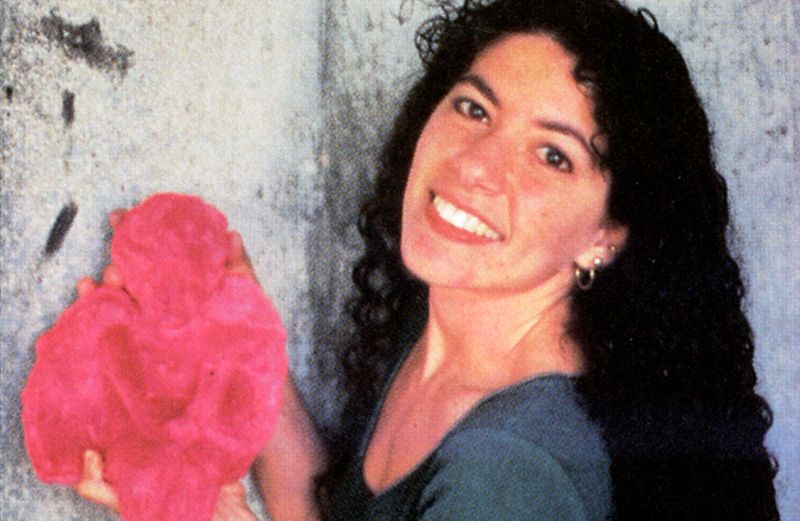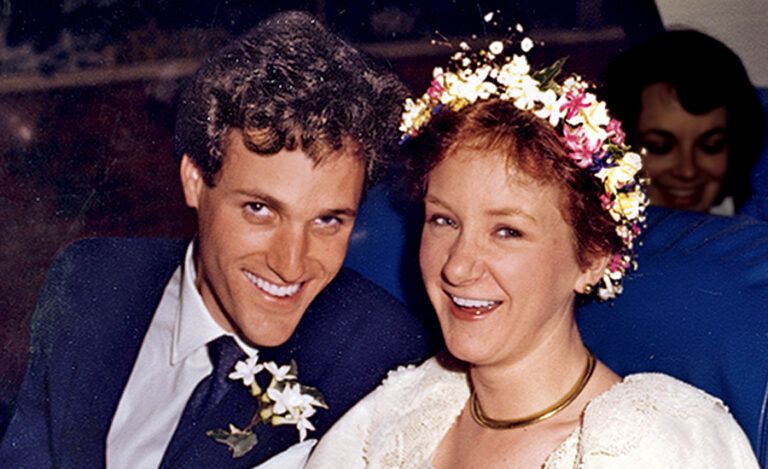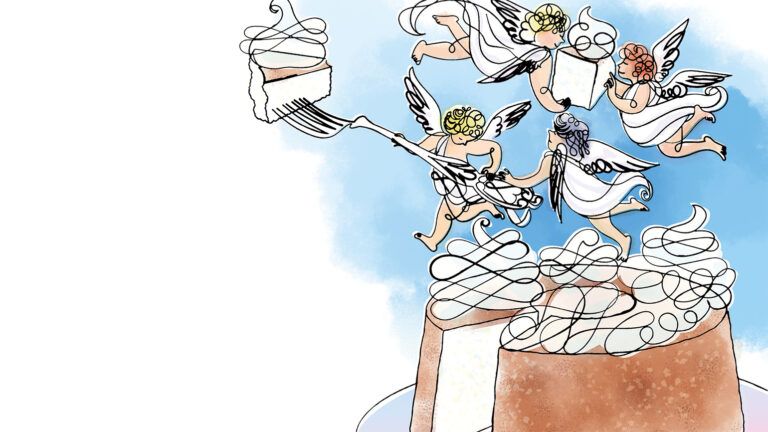I was heading south on the Golden State Freeway one evening, looking for the Main Street exit in downtown L.A. It was just moments after the sun had dropped below the horizon.
I noticed the evening star. Probably the only star I’ll see tonight, I thought. I had believed as a child that the stars were hovering angels, waiting to be called upon to help us with their all-embracing love. How fitting that their presence is dimmed by the harsh glare of city lights.
Los Angeles. The name conjures up images of riots, murders, floods, forest fires and earthquakes. Instead of seasons, Los Angeles has catastrophes.
But its name comes from the Spanish for “Our Lady, Queen of the Angels.” And I was on my way to interview 30-year-old artist Jill D’Agnenica, who has given herself a mission: spreading thousands of angels across the vast, turbulent metropolis.
I turned left off Main Street, as Jill had directed, and into the complex that housed her studio. A solitary smokestack rose up into the cloudless dark blue. A cluster of palm trees stood absolutely still, black against the disappearing light.
Beyond, four levels of crisscrossing freeways blazed with rush-hour traffic.
In the past 18 months Jill had made no less than 4,500 bright-pink plaster angels and distributed them throughout the city. They are free and are meant to be adopted by people. After a while, locals began to keep an eye out for them. Everybody wanted to find an angel.
“That was part of my original idea,” said Jill in the haze of pink dust enshrouding the downstairs portion of her live-in studio. “When people actually started to look for the angels, I knew I had accomplished what I had set out to do.” Which was?
“The city of L.A. is 468.7 square miles,” she explained. “I figured it would take approximately ten angels per square mile to have an impact. That means 4,687 angels, total.”
When she went to clean up for dinner, I looked around her studio. Plaster, pigment and rubber molds littered the place. Row upon row of drying angels sat in mute attention along shelves and on pallets on the floor.
“My assistants and I make each angel as an act of prayer,” she said. “We believe that one role of the artist is to promote healing in a community. That’s what we are trying to do.”
On the way to dinner we stopped off to buy gas. I was impressed by Jill’s fearlessness in this part of the city. Downtown Los Angeles can be daunting after dark. No one lives there—except a handful of artists and some homeless people.
I nearly jumped out of my skin when a burly, unshaven man appeared out of the dark to ask the time. But Jill was utterly unafraid.
We drove to a brightly lit noodle restaurant in Little Tokyo. In the booth she and I talked about the riots that had rocked the city in the spring of 1992. I didn’t move from my house for days, riveted by the images on television. Jill ventured out almost immediately.
“I sat by the TV for a while,” she said, “until the numbness started to get to me. At that point a friend and I drove down to Watts to see if there was something we could do.
“I’ll never forget it,” she went on. “There were people from all over the city who had come down to help clean up—people who would otherwise never consider driving to Watts.”
Shortly thereafter, a magazine cover blared, “Has the City of Angels Gone to Hell?” Jill was incensed. “What the city needed was healing, not more hurt.
“The rest of the year was difficult for me,” she said. “I kept trying to force myself into my studio, but I wasn’t motivated. I didn’t feel creative. It was all I could do to drag myself out of bed to drive to my job as a waitress at my parents’ restaurant.”
At this point Jill excused herself from the table. She went out to her truck and came back holding one of her angels. She gave it to the head busboy, who beamed with delight, hugging the bright-pink figure to his stained apron.
“That’s Mario,” Jill said when she returned to our table. “I’d promised him an angel. He got number 4,508.”
Jill then described the cement angel that began her mission. She had bought it on impulse at a craft store, painted it pink and put it on a shelf in her bathroom. That could have been the end of it, except that something insistent, almost urgent, told her to share the angel. But how?
Then late one night, when Jill was driving home after work, the L.A. skyline looming above the freeway beckoned to her. In a moment of inspiration an idea came to her. Finally she knew what to do with the angel.
The plan was simple: Place pink angels in every square mile of the city. The first four angels went out at dawn on April 29, 1993, the anniversary of the Los Angeles riots.
Jill set them on the front stoop of the First A.M.E. Church in South Central L.A., where a banner above the church read, “Brothers, Come Help Us Stop the Madness.”
Working alone and relying on her waitress’s wages, Jill was able to place 40 angels in six months. Then she won a grant for $4,500, all of which she spent on materials to make more angels. Her modest income now went to hire a full-time assistant.
By the seventh month, the two of them were able to distribute 300 angels.
The only snafu came when Jill sat 60 angels on the steps of City Hall on the eve of elections in November 1993. Before anyone arrived for work the next morning, all 60 were gone—they had been confiscated by the night watchman. “I call them my fallen angels,” Jill said, laughing.
By then the local media had begun to write about the angel phenomenon sweeping the city. Jill’s grant money had run out and she had started using her Visa card to make more angels when CBS News Sunday Morning aired an eight-minute segment about her.
“My phone started ringing off the hook. It rang for three weeks straight. People called from all over the country wanting angels, offering to make donations.”
All told, she received $6,000 in the mail. Besides money, the publicity brought in volunteers. “People wanted to help distribute angels. We started sending out ten trucks with two humans and eighty angels aboard each one, on the second Sunday of every month.”
Jill and I paid our bill and got up to leave. One of the other customers approached her shyly. “Are you the angel lady?” he asked.
Jill smiled and nodded.
“Oh, thank you!” he blurted out. “I came across the ones you put near the Laundromat in Silverlake and I was in such a terrible mood that day. Seeing them there, so bright and pink and peaceful, turned my day around.”
Each of Jill’s angels is numbered on the bottom, and its placement in the city is recorded with a photograph and logged in a ledger. Jill then enters that information into a computer on a software program donated to her by Thomas Bros. Maps.
At the end of her project she’ll be able to print out a huge map of the city with exactly 4,687 angel placements marked on it.
“When it’s over, all I’ll have left will be this map and the photographs of the angels,” said Jill. “But I will have fulfilled my role as an artist to help bring together our city.”
Back in her studio I asked her what she thought angels were.
“I have heard it said that angels are God’s thoughts passing to man, and man’s thoughts passing to God,” Jill told me. “These angels are my prayers of peace for the people of Los Angeles.”
It was well past midnight when I headed north on the freeway to return home. As I drove, I glanced up at the sky and saw stars. A feeling of love swept over me. Angels were everywhere.
Download your FREE ebook, Angel Sightings: 7 Inspirational Stories About Heavenly Angels and Everyday Angels on Earth






